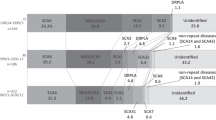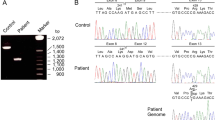Abstract
Haw River Syndrome (HRS) is a dominant neurodegenerative disease that has affected five generations of an African–American family in rural North Carolina. The disorder represents a unique spectrum of multiple system degenerations resembling Huntington's disease, spinocerebellar atrophy and dentatorubropallidoluysian atrophy (DRPLA), a neurodegenerative disease that has been primarily reported in Japan. Recently, DRPLA has been shown to be due to an expanded trinucleotide repeat located on chromosome 12pter–p12. We have genotyped this family and found MRS to be tightly linked to the DRPLA region. Further examination demonstrates that, despite their distinct cultural origins and clinical and pathological differences, MRS is caused by the same expanded CTG–B37 repeat as DRPLA.
This is a preview of subscription content, access via your institution
Access options
Subscribe to this journal
Receive 12 print issues and online access
$209.00 per year
only $17.42 per issue
Buy this article
- Purchase on Springer Link
- Instant access to full article PDF
Prices may be subject to local taxes which are calculated during checkout
Similar content being viewed by others
References
Farmer, T.W. et al. Ataxia, chorea, seizures and dementia. Pathologic features of a newly defined familial disorder. Arch. Neurol. 46, 774–779 (1989).
Nagafuchi, S. et al. Dentatorubral and pallidoluysian atrophy expansion of an unstable CAG trinucleotide on chromosome 12p. Nature Genet. 6, 14–18 (1994).
Koide, R. et al. Unstable expansion of CAG repeat in hereditary dentatorubral-pallidoluysian atrophy (DRPLA). Nature Genet. 6, 9–13 (1994).
Farmer, T.W., Wingfield, M.S., Jacobson, P.L., Katchinoff, B.L., Lynch, S.A. & Curnes, J.T. Neuroimaging of a new familial disorder. J. Neuroimag. 1, 123–128 (1991).
Lizuka, R., Hirayama, K. & Maehara, K.A. Dentato-rubro-pallido-luysian atrophy, a clinico-pathological study. J. Neurol. Neurosurg. Psych. 47, 1288–1298 (1984).
Lizuka, R. & Hirayama, K. Dentato-rubro-pallido-luysian atrophy. in Handbook of Clinical Neurology (eds Vinken, P.J., Bruyn, G.W. & Klawans, H.L.) 437–443 (Amsterdam, Elsevier, 1986).
Singer, C. ‘How River syndrome’ or dentato-rubro-pallido-luysian atrophy? Arch. Neurol. 49, 13–14 (1992).
Farmer, T.W., Hulette, C.M. & Vogel, F.S. In Reply, Haw River Syndrome or Dentato-Rubro-Pallido-Luysian Atrophy. Arch. Neurol. 49, 13–14 (1992).
Warner, T.T., Williams, L. & Harding, A.E. DRPLA in Europe. Nature Genet. 6, 225 (1994).
Stine, O.C. et al. Correlation between the onset age of Huntingdon's disease and length of the trinucleotide repeat in IT-15. Hum. molec. Genet. 2, 1547–1549 (1993).
Andrew, S.E. et al. The relationship between trinucleotide (CAG) repeat length and clinical features of Huntington's disease. Nature Genet. 4, 398–403 (1993).
Baker, H.E. et al. Aminoacid polymorphism in human prion protein and age at death in inherited prion disease. Lancet 337, 1286 (1991).
Farrer, L.A. et al. The normal Huntingdon disease (HD) allele, or a closely linked gene, Influences age at onset of HD. Am. J. hum. Genet. 53, 125–130 (1993).
Ben Othmane, K. et al. Linkage of Tunisian autosomal recessive Duchenne-like muscular dystrophy to the pericentromeric region of chromosome 13q. Nature Genet. 2, 315–317 (1992).
Li, S.H., Mclnnis, M.G., Margolis, R.L., Antonarakis, S.E. & Ross, C.A. Novel triplet repeat containing genes in human brain, cloning, expression and length polymorphisms. Genomics 16, 572–579 (1993).
Haynes, C.S., Pericak-Vance, M.A., Hung, W.-Y., Deutsch, D.B. & Roses, A.D. PEDIGENE — a computerized data collection and analysis system for genetic laboratories. Am. J. hum. Genet. 43, A146 (1988).
Haynes, C.S., Pericak-Vance, M.A. & Dawson, D. Analysis of Huntington Disease linkage and age-of-onset distributions. Genet. Epid. Supplement 1, 235–239 (1986).
Edwards, M.C., Clemens, P.R., Tristan, M., Pizzuti, A. and Gibbs, R.A. Pentanucleotide repeat length polymorphism at the human CD4 locus. Nucl. Acids Res. 19, 4791 (1991).
Author information
Authors and Affiliations
Rights and permissions
About this article
Cite this article
Burke, J., Wingfield, M., Lewis, K. et al. The Haw River Syndrome: Dentatorubropallidoluysian atrophy (DRPLA) in an African–American family. Nat Genet 7, 521–524 (1994). https://doi.org/10.1038/ng0894-521
Received:
Accepted:
Issue Date:
DOI: https://doi.org/10.1038/ng0894-521
This article is cited by
-
Genetic ataxias: update on classification and diagnostic approaches
Current Neurology and Neuroscience Reports (2021)
-
Exploring the Potential of Small Molecule-Based Therapeutic Approaches for Targeting Trinucleotide Repeat Disorders
Molecular Neurobiology (2020)
-
Case report of optic atrophy in Dentatorubropallidoluysian Atrophy (DRPLA)
BMC Neurology (2015)
-
Diagnosis and Treatment of Chorea Syndromes
Current Neurology and Neuroscience Reports (2015)



